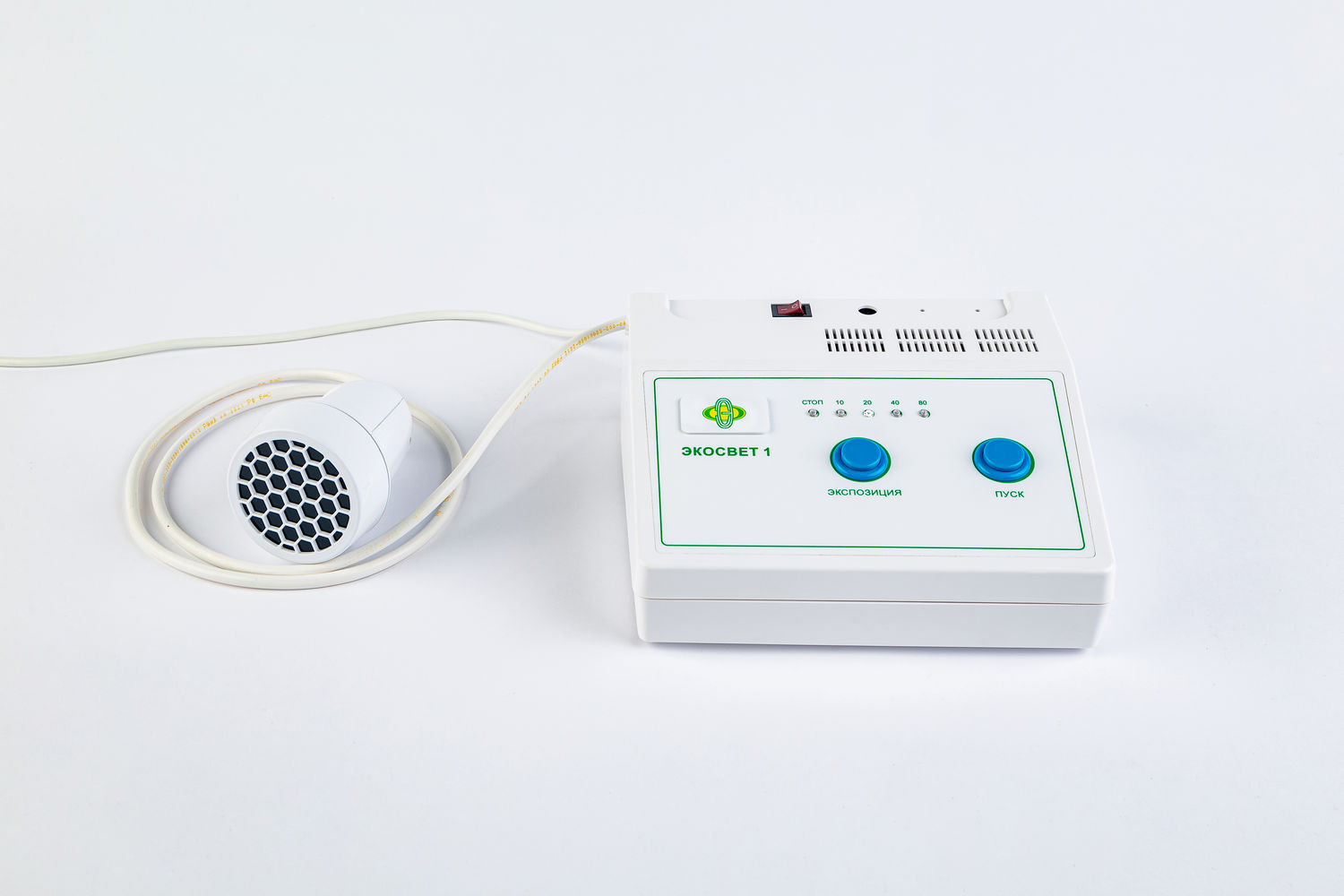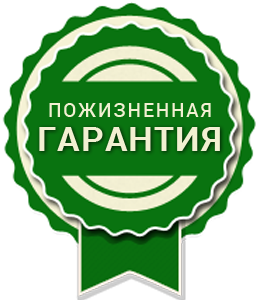Description
The device is designed to stimulate non-specific protection of cellular and humoral immunity, to provide a general strengthening and anti-inflammatory effect, and is indicated for a number of common diseases (see Instructions for Medical Use). Due to pulsed exposure in a short period of time, UV radiation practically does not cause erythema.

The mechanism of action and the effect achieved are ensured by using the UVR pulsed mode simultaneously in 2 parts of the UV range (A, B), and also, partially, in the visible and infrared wavelength ranges (less than 1%). As in the case of laser radiation (Kochetkov A.V., Moskvin S.V., 2004), UVR in pulsed mode is much more effective than continuous one due to the trigger effect on the body: it launches local and generalized reactions and processes that are aimed at restoring impaired functions organs and tissues, to restore local damage (systemic adaptive reaction of a living system with its various manifestations at all levels of life – Ulashchik V.S., 2008).
The trigger effect, according to Gurevich K.Ya., Kostyuchenko A.L., Belotserkovsky M.V. Kholmogorov V.E., consists in the development of chain free radical reactions, which explain such a rapid photomodification of blood. UV radiation leads to the formation of free radicals of aromatic and sulfur-containing proteins, pyrimidine bases of nucleic acids. Radicals of this type are involved in the transfer of electrons in the respiratory chain of mitochondria; such radicals arise, for example, in the interaction of phenolic antioxidants with lipid free radicals. Free radical lipid oxidation plays a leading role in many effects of UV irradiation (Kozinets G.I.). According to Chalenko V.V., Medvedev A.N., Rakovshchik D.G. (1992), according to the degree of exposure, physiological photoeffects can be conditionally divided into the following groups:
- 1. Influence of UVB on individual biologically active substances of blood plasma, that is, a molecular effect;
2. The impact of UVB on the functional systems of blood plasma;
3. Influence of UVB on blood cells and their function;
4. Effect of UVB on whole blood and its components.
Английский Klinicheskaya effektivnost’ UFOK obuslovlena immunoreguliruyushchim deystviyem (Samoylova K.A., 1989). Odnako neposredstvennyy effekt UFOK na immunokompetentnyye kletki i razlichnyye aspekty ikh funktsional’nogo sostoyaniya izucheny nedostatochno. Po dannym Ashinova N.A. (1999) posle UFOK proiskhodyat izmeneniya ekspressii differentsirovochnykh retseptorov CD3, CD5 i SD8-retseptorov limfotsitov, umen’shayetsya ekspressiya markerov aktivatsii limfotsitov CD25 i DR-antigena, uvelichivayetsya produktsiya IL-1, FNO. The clinical effectiveness of UBI is due to the immunoregulatory effect (Samoilova K.A., 1989). However, the direct effect of UVB on immunocompetent cells and various aspects of their functional state have not been studied enough. According to Ashinov N.A. (1999) after UBI, there are changes in the expression of differentiation receptors CD3, CD5 and CD8 receptors of lymphocytes, the expression of markers of activation of lymphocytes CD25 and DR antigen decreases, the production of IL-1, TNF increases. The mechanism of action of UVB is due to the stimulation of immunity and the effect on bacteria, the removal of medium molecular proteins from the body, the reduction of arterial hypoxemia, the improvement of the oxygen transport function of erythrocytes and the activation of redox processes (Vetchinnikova O.V., 1995; Kostyuchenko A.L., 2000; Tatarchenko I.P., Komarov V.T., 2001).
Ultraviolet irradiation activates erythro- and leukopoiesis, increases the nonspecific resistance of the organism. The identity of biological effects when exposed to blood UVI, helium-neon laser and daylight was shown in the works of K.A. Samoilova (1989) and V.I. Karandashov (1989-2001) et al. the main advantage of laser radiation – coherence – when it enters the tissues of the skin). The difference in the mechanisms of action at the molecular and cellular levels is due (at close values of the radiation intensity) mainly to the difference in the spectral and frequency characteristics.
The main therapeutic effects of long-wave UV (DUV) are immunostimulating and photosensitizing effects (Bogolyubov V.M., Ponomarenko, 1998), however, in the case of pulsed exposure with a pulse length of not more than 0.001 s, there is no pigment-forming effect characteristic of continuous DUV irradiation, because To. with such a duration, biochemical processes with the formation of melanin “do not have time” to occur.
In addition, UVR causes a change in the functional state of the central nervous system and the cerebral cortex: there is an improvement in blood circulation, an increase in the secretory activity of digestion and metabolism (Ulashchik V.S.). The main therapeutic effects of medium-wave ultraviolet (SUV) with suberythemal amount of exposure: vitamin-forming, immunomodulatory, anti-inflammatory, analgesic. Due to the wide spectrum of radiation, similar to solar in the UV region, the mechanism of action is the most physiological. Due to the trigger effect (“turning on” the body’s defenses to the action of an external stimulus), an improvement in the functional state is observed in organs that are not directly exposed to radiation. Taking into account the frequency characteristics of the organism, as well as the spectral adaptation of the radiation of a light pulse, can significantly enhance the effect of exposure.
It should be noted that, as in the case of laser exposure, none of the existing hypotheses fully reveals the mechanism of the biological response to pulsed polychromatic light irradiation. For example, it would be interesting to investigate the “resonance hypothesis”, which may be based on the effect of the so-called “mitogenetic radiation” known for about 90 years (Gurvich, 1923).
At the same time, NPSIT has significant advantages compared to laser radiation: a wide spectral range, adapted to the body and blood in terms of spectral characteristics, is more effective; higher energy capabilities (especially in hemodynamic therapy); non-invasiveness, safety, shorter duration of the procedure.
The possibility of influencing any area of the patient’s body surface with a wide light beam is provided by a remote emitter unit connected to the control unit by a long flexible wire. The emitter is made in the form of a flashlight, which is easily located in the hand.
The device is intended for use in medical, preventive and research medical institutions. Application – areas of medicine – in accordance with the indications. On the recommendation of a doctor, it can be used at home.
Main indications for use:
1) in outpatient and spa practice – chronic inflammatory diseases of internal organs, diseases of the musculoskeletal system, metabolic disorders, cardiovascular, allergic, infectious diseases, chronic fatigue syndrome, and many others. others;
2) in dermatology – psoriasis, eczema, seborrhea, phlegmon, ulcers, etc.;
3) in surgical practice – purulent inflammatory diseases, acute inflammatory diseases of internal organs, sluggish ulcers and wounds.
Contraindications (practically the same as with traditional UVR in physiotherapy): hypersensitivity to UVR, porphyria, thrombocytopenia, hypocoagulation, acute cerebrovascular accident, liver and kidney disease with severe dysfunction, hyperthyroidism, systemic lupus erythematosus; autoimmune diseases. Drugs with photosensitizing effects that should generally be avoided when exposed to UV radiation:
– Antibiotics: dimethylchlortetracycline, nalidixic acid, sulfonamides.
– Antifungal drugs: griseofulvin;
– Antihistamines: promethazine;
– Diuretics: thiazide;
— Dyes: eosin;
— Flavoring agents: musk, 6-methylcoumarin;
– Furocoumarins: psoralen;
– Hypoglycemic drugs: chloropamide, tolbutamide;
– Tranquilizers: chlorpromazine, trifluoperazine.
As follows from the conclusions of medical organizations, the results of treatment are: improvement in blood test parameters (both general and immune), increase in the rheological properties of blood, increase and restoration of the immune status of the body, increase in redox and decrease in inflammatory processes, decrease in allergic reactions, start mechanism for the production of its own gamma-interferon in the body. The main scientific consultant of the research is the head of the Department of Restorative Medicine, Balneology and Physiotherapy of the Kuban State Medical University. honey. University, Corresponding Member of the Russian Academy of Medical Sciences, Doctor of Medical Sciences, Professor A.T. Bykov, under whose leadership immunological studies were carried out and the possibility of using the method in restorative medicine was proved. Research is ongoing.
Huge experience in the treatment of skin diseases (for example, psoriasis) using the apparatus “Ecolight 1” has been accumulated by Doctor of Medical Sciences, Professor F.Ya. Khairulin (research continues). Medical research was carried out at the departments of Kuban State Medical University: General Surgery (Head of the Department – Doctor of Medical Sciences, Prof. Yu.P. Savchenko); propadeutics of internal diseases (MD, Professor A.S. Adamchik) and on the basis of the Krasnodar City Clinical Hospital No. 1; at the Department of Clinical Immunology, Allergology of Kuban State Medical University and at CJSC “Center for Allergy and Immunology” – Head. department and director of the Center – d.m.s., prof. R.A.Khanferyan and others.
In addition, studies of the device have been (and are being) carried out in a number of central medical organizations of the country: in the Moscow Center for Biochronotherapy (Professor V.A. Borisov); in the Testing Center and Certification Authority for Medical Devices FGU “NIIT and IO Rosmedtekhnologii” (expert opinions were approved by Academician of the Russian Academy of Medical Sciences V.I. Shumakov and Corresponding Member of the Russian Academy of Medical Sciences, S.V. Gotye); Federal State Institution VNIIIMT of Roszdravnadzor (Doctor of Medical Sciences, Professor Yu.K. Larionov); Research Institute of Medical Primatology (Academician of the Russian Academy of Medical Sciences B.A. Lyapin). Currently, research on the Ecosvet device is being carried out: at the Federal State Institution “Russian Scientific Center for Restorative Medicine”; at the Department of Infectious Diseases of KubGMU, etc.
Today, Ecosvet1 devices are already successfully operating in a number of sanatoriums in the Krasnodar Territory and the city of Esentuki, in polyclinics in the city of Krasnodar (including the OAO TsVMR Krasnodar Balneotherapy Center). There is a successful experience of using the device at home.
The conclusions of the experts indicate that the use of the device as an immunity stimulator has a broad perspective, both in the treatment and prevention of common diseases (including seasonal ones, such as influenza). One of the promising areas of application of the method is predicted oncology (photodynamic procedure with the use of UV radiation sensitizers), as well as allergology, dermatology, ophthalmology, gynecology, endocrinology, infectious, including viral, diseases, etc.
By additional order, it is possible to develop modifications of the device for any conditions, including for use in medical vehicles, in the field, on board a ship, etc.
The Ecolight 1 device and the NPSIT method implemented by it are reflected in the Federal Program for the Implementation of Critical (Most Important) Technologies – clause 4.3.2. Methods and means of normalizing the immune system, i.e. as one of the priority areas in medicine. This is a real embodiment of the program of innovative development of our country.






Reviews
There are no reviews yet.